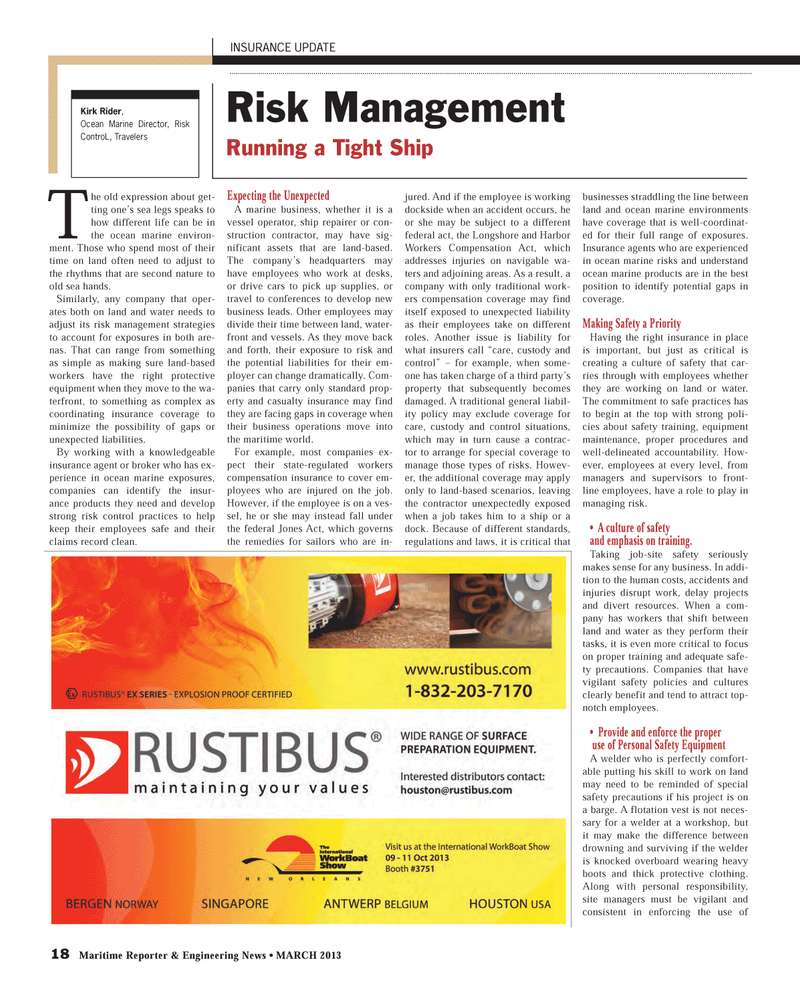
Page 18: of Maritime Reporter Magazine (March 2013)
U.S. Coast Guard Annual
Read this page in Pdf, Flash or Html5 edition of March 2013 Maritime Reporter Magazine
18 Maritime Reporter & Engineering News ? MARCH 2013 INSURANCE UPDATE Kirk Rider, Ocean Marine Director, Risk ControL, Travelers The old expression about get-ting one?s sea legs speaks to how different life can be in the ocean marine environ-ment. Those who spend most of their time on land often need to adjust to the rhythms that are second nature to old sea hands. Similarly, any company that oper- ates both on land and water needs to adjust its risk management strategies to account for exposures in both are-nas. That can range from something as simple as making sure land-based workers have the right protective equipment when they move to the wa-terfront, to something as complex as coordinating insurance coverage to minimize the possibility of gaps or unexpected liabilities.By working with a knowledgeable insurance agent or broker who has ex-perience in ocean marine exposures, companies can identify the insur- ance products they need and develop strong risk control practices to help keep their employees safe and their claims record clean.Expecting the UnexpectedA marine business, whether it is a vessel operator, ship repairer or con- struction contractor, may have sig- nificant assets that are land-based. The company?s headquarters may have employees who work at desks, or drive cars to pick up supplies, or travel to conferences to develop new business leads. Other employees may divide their time between land, water- front and vessels. As they move back and forth, their exposure to risk and the potential liabilities for their em-ployer can change dramatically. Com- panies that carry only standard prop-erty and casualty insurance may find they are facing gaps in coverage when their business operations move into the maritime world.For example, most companies ex-pect their state-regulated workers compensation insurance to cover em-ployees who are injured on the job. However, if the employee is on a ves- sel, he or she may instead fall under the federal Jones Act, which governs the remedies for sailors who are in-jured. And if the employee is working dockside when an accident occurs, he or she may be subject to a different federal act, the Longshore and Harbor Workers Compensation Act, which addresses injuries on navigable wa-ters and adjoining areas. As a result, a company with only traditional work-ers compensation coverage may find itself exposed to unexpected liability as their employees take on different roles. Another issue is liability for what insurers call ?care, custody and control? ? for example, when some-one has taken charge of a third party?s property that subsequently becomes damaged. A traditional general liabil- ity policy may exclude coverage for care, custody and control situations, which may in turn cause a contrac-tor to arrange for special coverage to manage those types of risks. Howev-er, the additional coverage may apply only to land-based scenarios, leaving the contractor unexpectedly exposed when a job takes him to a ship or a dock. Because of different standards, regulations and laws, it is critical that businesses straddling the line between land and ocean marine environments have coverage that is well-coordinat-ed for their full range of exposures. Insurance agents who are experienced in ocean marine risks and understand ocean marine products are in the best position to identify potential gaps in coverage.Making Safety a PriorityHaving the right insurance in place is important, but just as critical is creating a culture of safety that car- ries through with employees whether they are working on land or water. The commitment to safe practices has to begin at the top with strong poli-cies about safety training, equipment maintenance, proper procedures and well-delineated accountability. How- ever, employees at every level, from managers and supervisors to front-line employees, have a role to play in managing risk.? A culture of safety and emphasis on training.Taking job-site safety seriously makes sense for any business. In addi-tion to the human costs, accidents and injuries disrupt work, delay projects and divert resources. When a com- pany has workers that shift between land and water as they perform their tasks, it is even more critical to focus on proper training and adequate safe-ty precautions. Companies that have vigilant safety policies and cultures clearly benefit and tend to attract top-notch employees.? Provide and enforce the proper use of Personal Safety Equipment A welder who is perfectly comfort- able putting his skill to work on land may need to be reminded of special safety precautions if his project is on a barge. A flotation vest is not neces- sary for a welder at a workshop, but it may make the difference between drowning and surviving if the welder is knocked overboard wearing heavy boots and thick protective clothing. Along with personal responsibility, site managers must be vigilant and consistent in enforcing the use of Risk ManagementRunning a Tight Ship MR #3 (18-25).indd 18MR #3 (18-25).indd 183/4/2013 12:26:16 PM3/4/2013 12:26:16 PM

 17
17

 19
19
